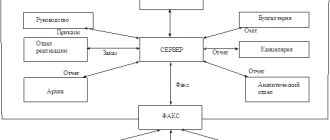Speech as a means of communication
Verbal (from Latin verbalis - verbal) communication is carried out using speech or language.
Speech is a natural sound language, that is, a system of phonetic signs (words), which include two principles - lexical and syntactic. Speech is a universal means of communication, since when transmitting information with its help, the meaning of the message will be least likely to be lost.
Verbal means of communication are written and spoken speech, reading and listening. With the help of oral and written speech, a text is created, which is a process of transmitting information, and listening and reading help to perceive the text that contains information.
70 SPEECH AS A MEANS OF COMMUNICATIONThe main essence of communication is the transfer of information. And information can be conveyed in completely different ways, the main thing is that the interlocutors understand each other. Information can be conveyed by non-verbal means of communication - gesture, nod of the head, facial expressions, etc.
There is, for example, the language of the deaf and dumb, and this is also a means of communication, as it conveys information, and can do this quite emotionally. Even silence itself can be a means of communication, conveying information based on emotional intensity or the length of the pause.
But still, the best means of communication, i.e. transmitting information, is human speech.
The term “speech” has not one, but three meanings. The first is speech as the process of speaking; second – speech as a product of speaking, i.e. text (no matter written or oral); and third - speech as an oratorical genre.
In the first case, we mean fluency in the mechanism of speech, i.e., how intellectually developed a person is, how quickly he can choose the right word, the purity of his speech, the absence of pronunciation defects. Most often, this term refers to everyday colloquial speech that everyone speaks, good or bad. The main task of this type of speech is to convey information to the listener, and for this it is not necessary to have special oratorical abilities, as in the third definition of speech, where speech is elevated to the rank of art. In this case, speech is not just a means of communication, although it also carries information. This is a beautiful, delivered speech that has a goal, objectives and topic. It is designed for a specific listener. And if it is considered as a process, it is more subtle and psychologically calculated. The speeches of the great speakers remained in the memory of posterity as evidence of the culture and high level of development of the people who spoke them. But once again it should be emphasized that these speeches are designed for human psychology, the beauty and power of words.
The second meaning of speech, i.e. speech as the result of a process, is addressed to the choice and use of language means (phonetic, lexical). The text carries information, but is not a means of communication in the full sense of the word.
What is more important for us is speech as a process, what means of language are used in colloquial speech in order to make it more informative and at the same time more emotional. All kinds of vernacular, proverbs and sayings, which, on the one hand, reduce the level of normativity of speech, on the other, enrich it. The speaker’s speech should be simple and figurative enough so that the listener does not have any misunderstandings. In colloquial speech, such a linguistic technique as asking again is often used. Usually it demonstrates the insufficient level of language proficiency of the interlocutors.
For stylists, colloquial speech can be interesting from a research point of view, since live speech is constantly changing and tracking these changes is very important.
There is also normative, or literary, speech. It is more likely to come into contact with oratory, since public speaking can be a striking example of it.
Table of contents
Types of speech activity
From the point of view of the mechanisms of encoding - decoding information, speech activity consists of four main aspects, called types of speech activity: speaking, listening, writing, reading.
- Speaking is the sending of speech acoustic signals that carry information.
- Hearing (or listening) is the perception of speech acoustic signals and their understanding.
- Writing is the encoding of speech signals using graphic symbols.
- Reading involves deciphering graphic signs and understanding their meanings.
A person activates information encoding mechanisms when he speaks and writes, and decoding mechanisms when he listens and reads. When speaking and listening, a person uses acoustic signals, and when writing and reading, he uses graphic signs.
These types of speech activity are the basis in the process of speech communication. The effectiveness and success of a person’s verbal communication depends on how well the person has developed the skills of these types of speech activities.
Speech can be divided into internal, when a person mentally talks to himself, through which he realizes the motives of his behavior, plans and manages activities; and external, which is aimed at the communication partner (Fig. 1). Inner speech is not communication because it does not involve dialogue.
Rice. 1. - Types of speech
Inner speech is the basis for outer speech. When translating the content of internal speech into external speech, there is a difficulty in speaking out loud (this can be seen in the students’ oral responses, which clearly reflect these difficulties).
Speech and its functions
20
Content
- Introduction
- 1. Speech and its functions
- 2. Types of speech activity and their features
- 3. Theories of speech development
- 4. Speech disorders
- Conclusion
- Bibliography
Introduction
The most important achievement of man, which allowed him to use universal human experience, both past and present, was speech communication, which developed on the basis of work activity. Speech is language in action.
The main thing that puts human speech above all other means of communication is the child’s ability, already at a very early age, to understand and construct from several dozen sounds of his native language an unlimited number of speech signals, which in most cases the child has not previously uttered or heard and which will have for him and for those around him a certain meaning.
Humans have an extremely high ability to think. However, this ability, as well as the perception and memory that underlies it, would be much weaker if a person, simultaneously with these processes, had not developed a tool that serves as their continuation and addition - speech.
1. Speech and its functions
Speech is the main means of human communication. Without it, a person would not have the opportunity to receive and transmit a large amount of information, in particular that which carries a large semantic load or captures something that cannot be perceived with the help of the senses (abstract concepts, not directly perceived phenomena, laws, rules, etc.) .P.). Without written language, a person would be deprived of the opportunity to find out how people of previous generations lived, thought and did. He would not have the opportunity to communicate his thoughts and feelings to others. Thanks to speech as a means of communication, a person’s individual consciousness, not limited to personal experience, is enriched by the experience of other people, and to a much greater extent than observation and other processes of non-speech, direct cognition carried out through the senses: perception, attention, imagination, memory can allow. and thinking. Through speech, the psychology and experience of one person become accessible to other people, enrich them, and contribute to their development.
In terms of its vital significance, speech is multifunctional. It is not only a means of communication, but also a means of thinking, a carrier of consciousness, memory, information (written texts), a means of controlling the behavior of other people and regulating a person’s own behavior. According to its many functions, speech is a polymorphic activity,
those. in its various functional purposes it is presented in different forms: external, internal, monologue, dialogue, written, oral, etc. Although all these forms of speech are interconnected, their purpose in life is not the same. External speech, for example, plays mainly the role of a means of communication, internal speech - a means of thinking. Written speech most often acts as a way to remember information. Monologue serves the process of one-way, and dialogue serves the process of two-way exchange of information.
It is important to distinguish language from speech. Their main difference is as follows. Language
is
a system of conventional symbols, with the help of which combinations of sounds are transmitted that have a certain meaning and meaning for people.
Speech
is a set of spoken or perceived sounds that have the same meaning and meaning as the corresponding system of written signs. Language is the same for all people who use it; speech is individually unique. Speech expresses the psychology of an individual person or a community of people for whom these speech features are characteristic; language reflects the psychology of the people for whom it is native, and not only people living today, but also all others who lived before and spoke the language. in this language.
Speech without language acquisition is impossible, while language can exist and develop relatively independently of a person, according to laws not related to either his psychology or his behavior.
The connecting link between language and speech is the meaning of the word .
It is expressed both in units of language and in units of speech.
At the same time, speech carries a certain meaning that characterizes the personality of the person who uses it. Meaning, unlike meaning, is expressed in those purely personal thoughts, feelings, images, associations that a given word evokes in this particular person. The meanings of the same words are different for different people, although the linguistic meanings may be the same.
Speech has three functions: signification
( designation ), generalization, communication ( transfer of knowledge, relationships, feelings ).
The significative function distinguishes human speech from animal communication. A person has an idea of an object or phenomenon associated with a word. Mutual understanding in the process of communication is thus based on the unity of designation of objects and phenomena by the perceiver and the speaker.
The generalization function is due to the fact that a word denotes not only a separate, given object, but also a whole group of similar objects and is always the bearer of their essential characteristics.
The third function of speech is the function of communication, i.e. transfer of information. If the first two functions of speech can be considered as internal mental activity, then the communicative function acts as external speech behavior aimed at contacts with other people. The communicative function of speech is divided into three sides: informational, expressive and volitional.
The information side is manifested in the transfer of knowledge and is closely related to the functions of designation and generalization.
The expressive side of speech helps to convey the speaker’s feelings and attitudes towards the subject of the message.
The volitional side is aimed at subordinating the listener to the speaker’s intention.
20
Fig.1
2. Types of speech activity and their features
In psychology, there are two main types of speech: external and internal. External speech includes oral (dialogue and monologue) and written. Dialogue is direct communication between two or more people.
Dialogical speech is supported speech; the interlocutor asks clarifying questions during the conversation, giving remarks that can help complete the thought (or reorient it).
A type of dialogic communication is a conversation in which the dialogue has a thematic focus.
Monologue speech is a long, consistent, coherent presentation of a system of thoughts and knowledge by one person. Monologue speech is coherent, contextual. Its content must first of all satisfy the requirements of consistency and evidence in the presentation. Another condition, inextricably linked with the first, is the grammatically correct construction of sentences.
A monologue does not tolerate incorrect construction of phrases. It places a number of demands on the tempo and sound of speech.
The substantive side of the monologue must be combined with the expressive side. Expressiveness is created both by linguistic means (the ability to use a word, phrase, syntactic construction that most accurately convey the speaker’s intention) and by non-linguistic communicative means (intonation, a system of pauses, the division of the pronunciation of a word or several words, which performs the function of a kind of emphasis, facial expressions and gestures).
Fig.2
Written speech is a type of monologue speech. It is more developed than oral monologue speech. This is due to the fact that written speech presupposes the absence of feedback from the interlocutor. In addition, written speech does not have any additional means of influencing the perceiver, except for the words themselves, their order and punctuation marks that organize the sentence.
Written and oral speech have a relatively complex relationship with each other. They are closely related to each other. But their unity also includes very significant differences. Modern written language is alphabetic in nature; signs of written speech - letters - indicate the sounds of oral speech. However, written language is not simply a translation of spoken language into written signs. The differences between them do not boil down to the fact that written and oral speech use different technical means. They are deeper. Great writers are well known who were weak speakers, and outstanding speakers whose speeches, when read, lose much of their charm. Written and spoken speech usually perform different functions. Oral speech for the most part functions as colloquial speech in a conversation situation, written speech - as business, scientific, more impersonal speech, intended not for the directly present interlocutor. In this case, written speech is aimed primarily at conveying more abstract content, while oral, colloquial speech is mostly born from direct experience. Hence a number of differences in the construction of written and oral speech and in the means that each of them uses.
With all the differences that exist between written and oral speech, it is impossible, however, to outwardly oppose them to each other. Neither oral nor written language represents a homogeneous whole. There are different types of both spoken and written language. Oral speech can be, on the one hand, colloquial speech, speech - conversation, on the other - speech, oratory, report, lecture. There are also different types of written speech: the letter will be significantly different in character and style from the speech of a scientific treatise; epistolary style is a special style; it approaches significantly the style and general character of oral speech. On the other hand, a speech, public performance, lecture, report, in some respects, is much closer in nature to written speech. Lecture, report, etc. have all the expressive means of oral speech. And the art of this form of oral speech includes the use of these expressive means; Contrary to the generally accepted expression about lecturing, a lecture cannot be turned into simply reading some text. Speech - a lecture should combine the features of both oral and written speech. Delivered before a silent audience, it must, to some extent, still be a lecture-conversation: a highly subtle sensitivity that captures the unspoken state of the audience, pliable or resistant, enthusiastic or bored, and the ability to immediately, as in a speech-conversation, take into account the barely perceptible reactions of listeners, their internal state and attitude to what was said - all these features of oral speech must be combined with strict systematicity and logical coherence of presentation, characteristic not of spoken oral speech, but of written speech.
Thus, if spoken speech differs very significantly from the written speech of a scientific treatise, then the distance separating an oral lecture - speech, report from written speech, on the one hand, and the style of colloquial speech from the epistolary style, on the other, is much less. This means, firstly, that oral and written speech are not external opposites, they influence each other; forms developed in one of them and specific to it are transferred to the other. This means, secondly, that the fundamental differences between the main types of oral colloquial speech and written scientific speech are associated not simply with the technique of writing and sound oral speech, but also with the difference in the functions that they perform; oral conversational speech is used to communicate with an interlocutor in conditions of direct contact and primarily for messages relating to what is directly experienced. Written speech usually serves the needs of more abstract thought. Significantly different from each other, and also in their relation to thinking, are external, loud oral speech and internal speech, which we mainly use when, thinking to ourselves, we cast our thoughts into verbal formulations.
Inner speech is a special type of speech activity. It acts as a planning phase in practical and theoretical activities. Therefore, internal speech, on the one hand, is characterized by fragmentation and fragmentation. On the other hand, misunderstandings in the perception of the situation are excluded here. Therefore, inner speech is extremely situational, in this it is close to dialogical. Inner speech is formed on the basis of external speech.
Inner speech differs from external speech not only in the external sign that it is not accompanied by loud sounds, that it is “speech minus sound.” Inner speech differs from external speech in its function. While it performs a different function than external speech, it also differs in some respects in its structure; proceeding under different conditions, it generally undergoes some transformation. Not intended for another, inner speech allows for “short circuits”; it is often elliptical, omitting what the user takes for granted. Sometimes it is predicative: it outlines what is being asserted, while omitting it as a matter of course, as known, what is being discussed; often it is built like a summary or even a table of contents, when the topic of thought, what is being discussed, is outlined, and what should be said is omitted as known. Acting as internal speech, speech, as it were, refuses to perform the primary function that gave rise to it: it ceases to directly serve as a means of communication in order to become, first of all, a form of internal work of thought. While not serving the purposes of the message, inner speech, however, like all speech, is social. It is social, firstly, genetically, in its origin: “internal” speech is undoubtedly a derived form from “external” speech. Proceeding under different conditions, it has a modified structure; but its modified structure also bears obvious traces of social origin. Inner speech and verbal, discursive thinking occurring in the form of inner speech reflect the structure of speech that has developed in the process of communication.
Inner speech is also social in its content. The statement that inner speech is speech with oneself is not entirely accurate. And internal speech is mostly addressed to the interlocutor. Sometimes this is a specific, individual interlocutor. “I find myself,” I read in one letter, “conducting an endless internal conversation with you for hours on end”; inner speech can be internal conversation. It happens, especially when there is a tense feeling, that a person conducts an internal conversation with another person, expressing in this imaginary conversation everything that, for one reason or another, he could not tell him in a real conversation. But even in those cases when inner speech does not take on the character of an imaginary conversation with a specific interlocutor, then it is devoted to reflection, reasoning, argumentation, and then it is addressed to some audience. The thought of each person expressed in words has its own audience, in the atmosphere of which his reasoning takes place; his internal argumentation is usually designed for and tailored to the audience; inner speech is usually internally directed at other people, if not at a real, then at a possible listener.
The translation of external speech into internal speech (interiorization) is accompanied by a reduction (shortening) of the structure of external speech, and the transition from internal speech to external speech (exteriorization) requires, on the contrary, the deployment of the structure of internal speech, its construction in accordance not only with logical rules, but also with grammatical rules .
The informativeness of a speech depends primarily on the value of the facts conveyed in it and on the ability of its author to communicate.
The intelligibility of speech depends, firstly, on its semantic content, secondly, on its linguistic features and, thirdly, on the relationship between its complexity, on the one hand, and the level of development, range of knowledge and interests of listeners, on the other.
Expressiveness of speech requires taking into account the situation of the speech, clarity and distinctness of pronunciation, correct intonation, and the ability to use words and expressions with figurative and figurative meaning.
3. Theories of speech development
Let's consider the basic psychological theories and the process of speech formation. One of them is theory
This theory states that imitation and reinforcement are the main mechanisms of formation and development in humans. It is assumed that the child has an innate need and ability to imitate, including the sounds of human speech. Receiving positive emotional reinforcement, imitation leads to the rapid assimilation, first, of the sounds of human speech, then of phonemes, morphemes, words, statements, and the rules of their grammatical construction. Mastering speech, therefore, comes down to learning all its basic elements.
This theory, however, is not able to satisfactorily and completely explain the process of language acquisition, in particular the speed with which a child masters speech in early childhood. In addition, for the development of any abilities, including speech, inclinations are necessary, which in themselves cannot be acquired as a result of learning (at least before learning begins). From the perspective of this theory, it is difficult to understand children’s word creation, as well as those moments in the development of a child’s speech that have no analogues in adults, i.e. those that cannot be learned by imitation.
Experience shows that adults reinforce in a child not so much grammatically correct statements as smart and truthful, original and semantically accurate statements. With this in mind, within the framework of the theory of speech learning it is difficult to explain the rapid formation of the correct grammar of speech utterances in children.
The author of the following theory of speech development is N. Chomsky. He claims that in the human body and brain from birth there are some specific inclinations for the acquisition of speech
in its main attributes.
These inclinations mature around the age of one and open up opportunities for accelerated speech development from one to three years. This age is called sensitive
for speech formation. Within broader age boundaries, it covers the period of a person’s life from one year to puberty (this refers not only to the acquisition of language as a means of communication, but also to its mastery at the conceptual level as a means of thinking). During this entire period of time, the development of speech usually occurs with complications, but outside of this period it is either difficult or impossible to acquire language. For this reason, adult immigrants learn a foreign language worse than their young children.
Another popular theory of language acquisition is called cognitive .
According to it, the development of speech depends on the child’s inherent ability from birth to perceive and intellectually process information. This, in particular, explains children's spontaneous word creation. It is assumed that speech development depends on the development of thinking, and not vice versa (J. Piaget). It has been established - and this is one of the main starting points of this theory - that the first statements of children usually relate to what they already understand. Children, in addition, usually talk about what is interesting to them. Consequently, the child’s motivation also influences the development of speech.
The development of speech can also be considered from a psycholinguistic perspective in terms of the formation of an increasingly perfect structure of speech. From this point of view, the process of speech development represents continuously and cyclically repeating transitions from thought to word and from word to thought, which become more and more conscious and rich in content. First, a thought is formed into a word, which simultaneously acts as both a phrase and a sentence, without further linguistically subtle division. The same poverty of forms and variations is characteristic of the reverse process of movement from word to thought. Then this process unfolds vertically (as shown in Fig. 3) and horizontally. The last movement is characterized by the expansion of possibilities for representing thoughts in words at different levels. For example, at the sentence and phrase levels, the same idea can be expressed differently by people with rich speech.
A child’s acquisition of speech begins with the selection of speech signals from the entire set of sound stimuli. Then, in his perception, these signals are combined into morphemes, layers, sentences, phrases. On their basis, coherent, meaningful external speech is formed, serving communication and thinking. The process of translating thoughts into words goes in the opposite direction.
Fig.3
4. Speech disorders
Speech disorders have been known since ancient times. Without a doubt, these diseases have existed as long as the human word. This is a fairly common phenomenon among both children and adults. The Greeks and Romans, for whom the public word played an important social role and the teaching of elegant speech and was included in the range of subjects of general education, already had an understanding of many speech disorders, which was reflected in a large number of terms used to designate them. Already in Hippocrates there are references to almost all forms of speech disorders known to us: loss of voice, loss of speech, tongue-tiedness, slurred speech, stuttering, etc.
From the point of view of communication theory: “speech disorders are violations of verbal communication” (L.S. Volkova).
People with speech impairment are distinguished by their criticality towards speech insufficiency, but speech pathology inhibits the formation of potentially intact mental abilities in them, preventing the normal functioning of speech intelligence. However, as verbal speech develops and speech difficulties are eliminated, their intellectual development approaches normal.
The cause of speech disorders is understood as the impact on the body of an external or internal harmful factor or their interaction, which determine the specifics of a speech disorder and without which the latter cannot occur. (L.S. Volkova)
The causes of speech impairment can be various factors or their combinations:
difficulties in distinguishing sounds by ear (with normal hearing);
damage during childbirth to the speech area located on the top of the head;
defects in the structure of the speech organs - lips, teeth, tongue, soft or hard palate. An example would be a short frenulum of the tongue, a cleft palate, popularly called a “cleft palate,” or an abnormal bite;
insufficient mobility of lips and tongue;
delayed speech development due to mental retardation;
illiterate speech in the family, etc.
With the most serious speech disorders, not only the pronunciation of sounds suffers, but also the ability to distinguish sounds by ear, active
(used in speech) and
passive
(the one that the child perceives by ear) vocabulary of the child, problems arise with the construction of sentences and phrases. All these violations, if not corrected in time in childhood, cause difficulties in communicating with others, and in the future can lead to the development of complexes in children, preventing them from learning and fully revealing their natural abilities and capabilities.
According to the severity, speech disorders can be divided into those that are not an obstacle to learning in a public school, and severe disorders that require special training. The most common severe speech disorders are alalia, various types of dysarthria, some forms of stuttering, etc.
Alalia is a complete or partial absence of speech in children with good physical hearing, caused by underdevelopment or damage to the speech areas of the brain. For sensory alalia
the child does not understand someone else's speech well, and does not recognize the sounds of speech: he hears that the person is saying something, but does not understand what exactly.
This is similar to how we do not understand speakers of a foreign language unknown to us. With motor alalia,
the child cannot master the language (its sounds, words, grammar).
Dysarthria (anarthria) is a pronunciation disorder that occurs as a result of damage to the nervous system. With dysarthria, it is not the pronunciation of individual sounds that suffers, but the entire speech. A child with dysarthria pronounces sounds unclearly, blurredly, his voice is quiet, weak, or, on the contrary, too harsh; the breathing rhythm is disturbed; speech loses its fluency, the pace of speech is abnormally accelerated or too slow. Often, children with dysarthria have impaired fine movements of the hand and are physically awkward.
Children with erased forms of dysarthria do not stand out sharply among their peers, and do not even always immediately attract attention. However, they have some peculiarities. So, these children speak unclearly and eat poorly. They usually do not like meat, bread crusts, carrots, or hard apples as they find it difficult to chew. After chewing a little, the child can hold the food in his cheek until adults reprimand him. Often parents make concessions to the baby - they give soft food so that he can eat. Thus, they, unwittingly, contribute to a delay in the child’s development of movements of the articulatory apparatus.
Dyslalia is a violation of the pronunciation of various sounds; another name for this type of speech disorder is tongue-tiedness. Types of tongue-tiedness are very diverse. To designate them, they usually use the Greek names of those speech sounds whose pronunciation is impaired: the distorted pronunciation of the sound “r” is called rhotacism, the sound “l” is called lambdaism, whistling and hissing sounds (“s”, “z”, “c”, “ w", "g", "g", "sch") - sigmaism (from the Greek letters "rho", "lambda", "sigma"). If the pronunciation of all consonants and sound combinations with the exception of “t” is impaired, so that speech becomes completely incomprehensible, then the term “thetism” is used (from the Greek name for the letter “t” (theta)).
Stuttering is a violation of the tempo, rhythm, and fluency of speech caused by convulsions and spasms in various parts of the speech apparatus. In this case, the child experiences forced stops or repetitions of individual sounds and syllables in his speech. Stuttering most often occurs in children between the ages of two and five years. It is very important not to miss the first signs of stuttering: the child suddenly becomes silent and refuses to speak. This condition can last up to several days. In this case, you should immediately consult a doctor.
Often the cause of stuttering is fear or prolonged mental trauma. Speech disorders in preschool age, in the absence of correctional work, will inevitably lead to problems at school, in particular, dysgraphia may develop - a writing disorder, the so-called tongue-tied writing. As a rule, it appears when the child begins to learn to read and write. The cause of this disorder is underdevelopment or impairment of phonemic hearing. By the way, saying out loud all the operations when writing a letter in the required sequence is a fairly effective means of teaching a child to think correctly about an action, that is, it can prevent the occurrence of graphic errors in younger schoolchildren.
In the first grades, a child may also develop dyslexia (alexia) - a violation of the process of reading or mastering it when various parts of the cortex of the left hemisphere are damaged (in right-handed people). Depending on which specific areas are affected, different types of alexia are distinguished.
Some speech disorders disappear with age, some of them can be eliminated with a little help from a speech therapist working with parents or at a speech center, in a children's clinic or in a regular kindergarten. Children with severe speech impairments require mandatory long-term assistance from a speech therapist in speech groups at speech therapy kindergartens. Moreover, the sooner you seek help from a speech therapist, the more successful the correction work will be.
Conclusion
Thus, let us note the meaning of speech. Speech is a means of communication, necessary primarily to involve the subject in the social environment. It is through speech that the first connections between mother and child are formed, the foundations of social behavior in a group of children are established, and, finally, it is through speech and language that cultural traditions significantly influence our way of thinking and acting.
Speech is a truly important means that a person resorts to when he needs to intelligently argue his attitude towards various life problems. However, this is only a secondary function of speech. Only a few people are engaged in one thing: they think logically, and with the help of speech they only give out the result of their thoughts. For most, speech is mainly a way to convey information, reflect on life events and internal states, or simply enjoy conversation.
Bibliography
1. L.D. Stolyarenko, V.E. Stolyarenko. Psychology and pedagogy for technical universities. Rostov-on-Don: 2001
2. R.S. Nemov. Psychology. Book 1. Moscow: 1999
3. www.probio. io/ru/reference
4. S.L. Rubinstein. Fundamentals of general psychology. St. Petersburg: 1998
5. www.azps.ru
Types of external speech
External speech can be oral and written.
Oral speech
Oral speech is a type of external speech in which words are voiced; it uses a system of phonetic and prosodic means of expression. This type of speech appears in the process of speaking. It is characterized by verbal improvisation and some linguistic features: freedom in the choice of vocabulary prevails, simple sentences are used, incentive, interrogative, exclamatory sentences, repetitions, and incomplete expression of thoughts are used.
Do you need help from a teacher? Describe the task - and our experts will help you!
Written speech
Written speech is a type of external speech when words are graphically consolidated. It can be thought out and corrected in advance. It is characterized by some linguistic features: it is dominated by book vocabulary, complex sentences, strict adherence to language norms, and there are no extra-linguistic elements.
The difference between oral and written speech
These differences must be taken into account in the process of business communication. They lie in the character of the addressee. Written speech is usually directed to those who are absent. People who write cannot see their communication partner, but can only mentally imagine him. Written speech is not influenced by the reactions of people who perceive it when reading it.
Oral speech presupposes the presence of an interlocutor. The one who speaks and the one who listens, in most cases, not only hear, but also see each other. Therefore, oral speech is dependent on its perception by other people. Reactions of approval or disapproval, demonstrations of understanding or misunderstanding can influence the nature of speech and change it depending on this reaction.
A person who speaks creates his speech immediately: he must simultaneously present both content and form. The one who writes always has the opportunity to change his text and correct it at his own discretion.
The nature of perception of oral and written speech
The perception of oral and written speech is different. Written speech is calculated with the condition for visual perception. When a person reads, he has the opportunity to re-read any passage several times to check the correctness of understanding. Oral speech is perceived by ear, so it should be constructed and organized in such a way that its content can be understood immediately and easily absorbed by listeners.
The difference between written and oral speech also lies in the fact that what is said and pronounced is short-lived, it remains in memory only partially, but what is written can be retained for a long time, as is said in the proverbs: “The word is not a sparrow, it will fly out - you won’t catch it”; “What is written with a pen cannot be cut out with an axe.”
Is it still difficult? Our experts will help you figure it out All services Problem solving from 1 day / from 150 rubles Coursework from 5 days / from 1800 rubles Abstract from 1 day / from 700 rubles —>
Types of speech activity and their features.
BASIC CHARACTERISTICS OF VERBAL COMMUNICATION
Plan
1. Speech as a means of communication: concept, functions and structure.
1. Speech as a means of communication: concept, functions and structure.
Verbal communication uses human speech and natural sound language as a sign system that mediates information interaction and communication[vi]. Speech is the most universal and important means of communication. According to scientists, two-thirds of human communication consists of verbal communication. Moreover, with the help of speech, the meaning of the message is least likely to be lost. True, this should be accompanied by a high degree of common understanding of the situation by the participants in the communicative process. Let's take a closer look at some of these issues.
Concept (term) “speech”
used in several meanings.
1. Speech as a special type of human activity, which exists along with other types of activity (labor, cognitive, etc.) and at the same time constitutes a component of all other types of activity.
2. Speech as a type of communication through language, which occurs in audio, written or other form. It is characterized by a set of certain lexical and grammatical means and is determined by the conditions and goals of communication, depending on which business, official speech, poetic speech, professional speech and etc.
3. Types of syntactic structure of a statement (indirect direct speech, abrupt speech, someone else’s speech, etc.).
4. Speech as a result of speech activity - text, article, message, report, etc.
Speech is the external manifestation of language. Language is realized in speech and only through it fulfills its communicative purpose.
Speech is a sequence of language units, organized and structured according to its laws and in accordance with the needs of the information expressed. Unlike language, speech can be assessed as good or bad, clear or incomprehensible, expressive or inexpressive, etc. The speaker (writer), carrying out this activity, uses the means of language for two main purposes: to communicate with other people or to communicate with to myself. Thus, speech as a psychological phenomenon correlates with the categories of thinking, memory, etc.
Functions of speech (language).
Each utterance performs one or another function in the communication process (attracting attention, establishing contact, transmitting information, etc.). Particular functions of specific utterances can be combined into more general ones, which are called functions of speech. Usually there are three main and a number of special functions.
The main functions include:
· communicative or representative
(representation - representation; image, image), which is dominant;
· appellate
(appeal - appeal, appeal, i.e. influence), which is grammatically most clearly expressed in the vocative form and the imperative mood (Andrey! Come here!);
· expressive
(expression - expression and expressiveness).
Among the private functions are:
· phatic
carried out through the exchange of ritual formulas, i.e. primarily affecting the area of speech etiquette (Good afternoon. Glad to see you. - Mutually. How are you doing?);
· metalinguistic
, i.e. interpretation function, when the speaker or listener needs to check whether they use the same code when communicating; thus, the subject of speech becomes the code itself (Do you understand what I mean? Clarify what you understand by the word happiness?).
In addition, they talk about poetic, emotive, voluntarily and a number of other functions.
However, it is unlikely to find speech messages that perform only one of these functions. The differences between messages do not lie in the exclusive manifestation of any one function, but in their different hierarchy. The verbal structure of a message depends primarily on the predominant function.
Thus, the system of speech functions represents a hierarchical structure. To fulfill its primary function as a means of communication, speech must perform specific functions of communication and message. To implement the latter, it is necessary to formalize thoughts, i.e. a representation function is assumed. Its constituent and subordinate parts are the functions of expression and appeal. In fact, the function of representation is impossible without both of its components, but they are also impossible without it. Thus, in the process of any speech act, private functions are also realized. At the same time, the nature of the impact on the interlocutor depends on which function predominates in a particular speech message.
The structure of verbal communication includes:
1. The meaning and meaning of words and phrases. The accuracy of the use of the word, its expressiveness and accessibility, the correct construction of the phrase and its intelligibility, the correct pronunciation of sounds and words, the expressiveness and meaning of intonation play a role.
2. Speech sound phenomena: speech rate (fast, medium, slow), voice pitch modulation (smooth, sharp), voice pitch (high, low), rhythm (uniform, intermittent), timbre (rolling, hoarse). Observations show that the most attractive in communication is a smooth, calm, measured manner of speech.
3. Expressiveness of voice quality: characteristic specific sounds that arise during communication: laughter, grunting, crying, whispering, sighs. Studies have shown that in the daily act of human communication, words make up 7%, intonations 38%, non-verbal interaction 53%.
People need to communicate with each other and with themselves, and also receive information from universal human socio-historical experience.
All these functions are provided by speech. Speech as a means of communication is the topic of today’s conversation.
Speech is the result of recoding thoughts into sound or graphic structures. When communicating through speech, three main elements function:
- subject of speech communication (who speaks),
- object (recipient) of the message;
- the speech message itself.
This means that success depends on three factors :
- characteristics of the speaker,
- the mental state and state of perception of the person receiving the message;
- quality of speech “products”.
The speech process is associated not only with mental manipulations of the psyche, but also affects the spheres of interpersonal and personal relationships. The attitude towards the situation is also conveyed through speech.
Let's look at what helps transmit speech:
- tone;
- voice volume;
- focus of gaze;
- certain body movements.
The tone of speech is a kind of indicator of the speaker’s mental state. The interlocutor very accurately grasps whether the speaker himself believes in his own words, what meaning he attaches to what was said, how he treats the person with whom he is communicating.
Voice volume . It also shows the intentions of the speaker and his attitude towards those who listen to him. For example, if they want to exert pressure or influence, they speak louder. In Europe, if they are indignant, they also increase the strength of their voice. but in the East in such cases they switch to a whisper.
Focus of gaze . Shows the true mood of the speakers and serves as a channel of communication between them. When embarrassed, the eyes usually droop, and an averted gaze can indicate the speaker’s insincerity.
Body movements. Strengthens the speaker's self-expression. Different cultures have their own norms of body movements, distance between interlocutors and gestures. We talk more about body language in European culture and its influence HERE.
However, the basis of verbal communication is the message itself. One should remember the unity of its content and form .
Content. Some people are used to just chatting, without really thinking about what they say. But any message carries not only information, but also a charge of energy. Later we will talk about how, for example, we program ourselves for ill health with the help of phrases, how we bring disaster upon ourselves. In the meantime, we are talking about speech as a means of communication.
Form. Even the most striking content will be lost and will not have the desired impact on listeners if it is presented in an inexpressive or inappropriate form.
So, if the feelings that we convey in poetry are presented in the form of an information note, then not only will the meaning of what was said or written be lost, but the text will seem pompous and insincere.
Construction of speech according to the laws of speech communication:
- assess (determine) the situation;
- we determine our attitude to the situation (i.e., reaction to the situation);
- explains what one would like to do (motivation for activity).
If the speaker loses control over emotions, then this structure changes. Often, first of all, statements are used that are not confirmed by an adequate assessment of the situation, for example, offensive ones. And when, having calmed down, we carry out the exercise of assessing the situation, we become ashamed. Moreover, such behavior can greatly damage relationships with people.
“Provocateur” words can also ruin relationships with people and cause conflictual communication: read about them HERE.
Usually in such cases the interlocutor either answers in the same spirit or remains silent. Negative emotions of the speaker generate negative emotions in the interlocutor (according to the law of generating emotions in the process of communication).
Conclusion: to avoid unpleasant situations, send messages imbued with positive emotions.
Definition of the situation . The speaker creates a picture of what is happening, records events and his attitude towards them. At the same time, if we want speech to have a greater impact, we look for bright, rich expressions, like a painter, we draw pictures, only with words:
“For one lost day, the enterprise loses so much. How much will it miss for thousands of lost days?! (numbers…)"
In speech, it is better not to use categorical expressions “never”, “always”, “forever”, etc., as well as evaluative cliches: “slobs”, “fools”, “parasites”... You should avoid anything that degrades human dignity.
Reaction to the situation. It is appropriate to express concern, experience, and surprise. Sarcasm and indignation can only be used if you intend to break up with the person.
However, it is better to avoid rage and insults, especially with obscene language, in any case. Such an attitude can temporarily stimulate only uninitiated performers and people-pleasers. Such a negative attitude disorganizes independent, creative and self-sufficient people.
Inspiration to activity. The speaker specifically, clearly, clearly formulates his advice, recommendation, request or reasoning.
Next time we will talk about the properties of good speech in communicating with people.
In the meantime, tell me, what kind of speech in communication would you call high-quality?
Did you like the post? Share it with your friends! —>
Speech is the main means of human communication.
Speech is the process of communication between people through language . With its help, a person receives and transmits information. Speech records what cannot be perceived with the help of the senses (abstract concepts, laws, rules). Written speech allows you to obtain information about the life of previous generations. Thanks to speech, a person’s personal experience is enriched by the experience of other people.
There are 4 main functions of speech:
o Expression -
We express our attitude towards a certain object, situation, person.
o Message –
Through words, information is exchanged between people.
o Designation –
we name objects and phenomena.
o Impact –
We influence the thoughts, emotions, and behavior of other people.
Its basic properties are directly related to the functions of speech
— Content–
volume and depth of information expressed in speech.
— Understandability–
the ability to use words, sentences, and concepts appropriate to the situation.
— Expressiveness –
emotional richness and coloring, the content of figurative expressions, metaphors, the ability to evoke a response in the interlocutor.
— Impact
– the ability to influence other people) their beliefs, emotions, motivation, etc.)
Speech involves the use of language - a means of communication between people; system of signs.
Language -
a socio-historical phenomenon determined by national characteristics. It exists independently of the individual. A language that is not used for live communication, but preserved in written sources, is called dead (for example, Latin).
Sign -
This is any material, sensory element of reality, acting in a certain meaning and used for storing and transmitting information. Linguistic signs do not exist in isolation from each other, but form a system that is built according to certain rules, creating the grammar of the language.
Signs that are part of languages as special means of communication between people are called signs of communication:
Natural languages -
These are words, accepted expressions, grammatically correct sentences, etc., which consist of sound signs and corresponding written signs. These include accepted systems of combinations of finger positions (language of the deaf and dumb), tattoos on paper (language of the blind). Telegraph code, signals given by flags, drum system, etc. can be used as linguistic signs.
Artificial
– encode natural languages (Morse code, traffic signs, etc.)
Speech without language acquisition is impossible, but language can exist and develop independently of a person.
The individuality of speech is explained by age, different levels of language proficiency (vocabulary, grammar, phonetics), education, and general cultural level. The speech of individual people reveals their professional characteristics, peculiarities of construction and pronunciation (for example, one person pronounces sounds clearly, clearly, loudly, another - indistinctly, quietly, slowly, a third - burrs, etc.), interest.
A person can use one language or several.
HomeCollection “Otherreferats”Psychology Speech as a means of communication
Speech communication as a method of communication
One of the main means of communication is speech, speech communication.
According to scientists, half a third of human communication consists of verbal communication. The concept of “speech” has several meanings: • a special type of human activity; • a type of communication using language (what is usually called a language style, a syllable), which is characterized by certain lexical and grammatical means depending on the conditions and goals of communication (business official speech, poetic speech, professional speech, etc.);
• types of syntactic construction of a statement (indirect
direct speech, abrupt speech, someone else’s speech, etc.).
We are primarily interested in the first meaning. Speech is a type of activity that exists along with other types of activity
(labor, cognitive, mnemonic, i.e. activity: memory, etc.).
Since “speech activity is a specialized absorption of speech for communication,
a special case of communication activity,” “speech is a potential component
of any
activity, for example, cognitive (mental), mnemonic, etc.”
(L* tyev A.A.
Psychology of communication. M., 1999. P. 56). The speaker (speaker), carrying out this activity, uses the means of language for two main purposes: to communicate with other people or to communicate with himself. Thus, speech as a psychological phenomenon correlates with the categories of thinking, memory, etc.
In linguistics, speech is studied within the opposition language - speech is usually understood as the implementation of a language system. This oppositionist;
was first identified and described by Saussure in his “Course of General Linguistics” (1916).
Saussure viewed speech activity as a kind of integral of language and speech. Language is, as it were, a potency, a certain system, the structure of which has not yet been fully studied, but which, despite this, is known to all members of a given linguistic community and is a product of its activity, i.e. is of a social nature. The language system finds its implementation in speech, i.e. language is constantly present in us in a state of possibility. Speech is actual, individual; speech is present in us from time to time in a state of reality. Developing Saussure's idea, researchers suggest that “speech activity as a whole, as an integral, contains a sequence: this is the sequence of transition of language, which constantly exists in the speaker (hence, regardless of the specific moment), to speech (into speech), which belongs to the speaker only in specific moments in time" (Guillaume G.
Principles of theoretical linguistics. M., 1992. P. 37).
The nature of the impact of the speaker’s (writer’s) speech on the interlocutor (reader) depends on how this transition is carried out.









